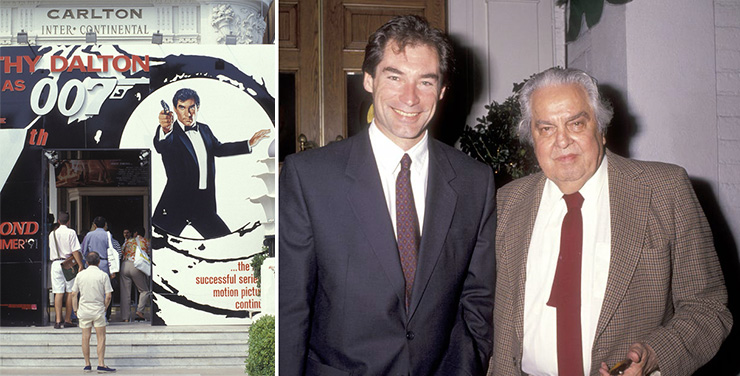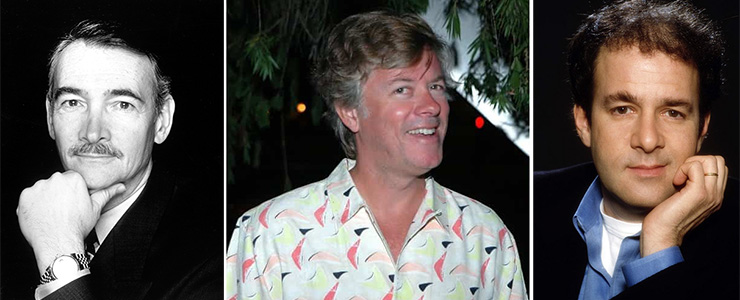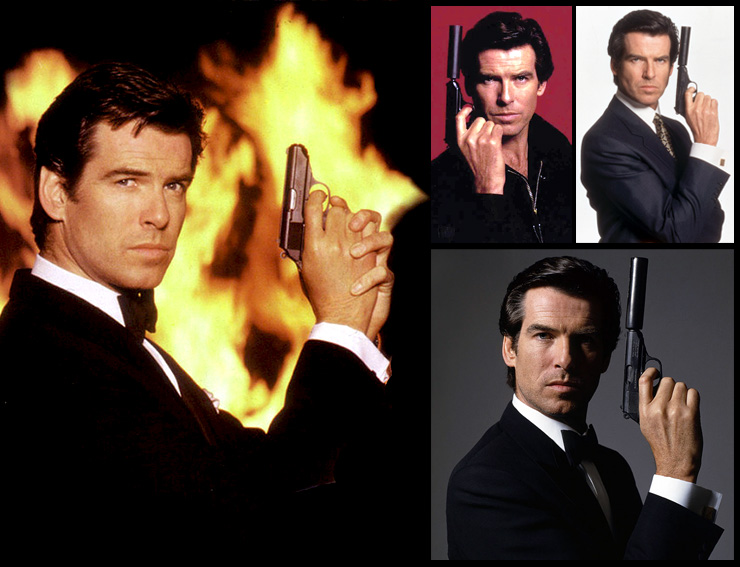| |
 |
|
KEVIN HARPER looks
back at the making of GoldenEye, released 30 years ago as the 17th
entry in the long-running EON Productions James Bond film series. After a
six-year absence James Bond returned to the big screen with a new actor in
the lead role. Following the box-office disappointment of Licence To
Kill (1989), Pierce Brosnan took James Bond to new heights of
international success after losing the role to Timothy Dalton in 1986.
Brosnan’s four-film tenure revitalised the franchise for a whole new
generation, going on to gross over one-billion dollars worldwide. |
 |
|
ABOVE: (left)
BOND 17 is promoted on the front of the Carlton Hotel during
the Cannes Film Festival in May 1990. The film was to star Timothy
Dalton for a Summer 1991 release. (right) Timothy Dalton with
James Bond Producer Albert R. Broccoli in 1991. The actor remained
friends with ‘Cubby’ Broccoli and his family until the Producer's
death in 1996. Timothy Dalton was one of the pall-bearers at
Broccoli's funeral in Los Angeles on July 1, 1996, and later
appeared with Roger Moore and Pierce Brosnan at a memorial event
held at London’s ODEON Leicester Square on Sunday November 17,
1996. |
|
|
|
After the release of
Licence To Kill in 1989 EON Productions continued with their ongoing
series, and the as yet untitled 17th instalment was promoted on the front
of the Carlton Hotel at the Cannes Film Festival in May 1990, with Timothy
Dalton slated to play James Bond for the third time in a film scheduled
for a Summer 1991 release. The actor was also keen to fulfil his original
contract with EON, and remained on good terms with Producer
Albert R.
Broccoli and his family. A first draft screenplay co-written by
Michael G.
Wilson & Alfonse Ruggiero (then best-known for writing several episodes of
the hit US TV series Miami Vice) was in place by April 1991. However, a
legal dispute between DANJAQ (the company which held the copyright and
trademarks to the characters, elements, and other material related to
James Bond on screen), and MGM/UA - the financier and distributor of the
films - halted production and the series went into hiatus until the
dispute was finally resolved in December 1992, by which time Timothy
Dalton’s seven-year contract had expired. Although Albert R. Broccoli
stayed loyal to Dalton, MGM/UA were not convinced he was the right man to
guarantee a financial hit given the relatively poor box-office takings for
Licence To Kill (1989), particularly in the USA. The actor was also unsure
about signing another long-term contract and informed ‘Cubby’ Broccoli
that he would probably not continue with the role. Broccoli eventually
convinced the actor to stay on, and in August 1993, Dalton told the Daily
Mail that production on BOND 17 was expected to begin in early 1994.
Although Dalton was happy to complete just one more Bond film to cap off
his run, Broccoli was keen to ensure a continuity of lead actor after
being off screen for several years. In a 2014 interview published in The
Week, Dalton recalled the Producer said to him: “Look, Tim. You can't do
one. There's no way, after a five-year gap between movies, that you can
come back and just do one.” Unwilling to sign up for ‘four or five’ more
films, Dalton respectfully declined to continue in the Bond role and
officially resigned on April 12, 1994. Albert R. Broccoli also now took a
back seat and handed the day-to-day production to his
daughter Barbara,
and stepson Michael G. Wilson who had been co-producing and
co-screenwriting the Bond films for several years. |
 |
|
ABOVE: WRITERS BLOCK
- The script that eventually became GoldenEye began life a
screen treatment co-written by Michael G. Wilson & Alfonse
Ruggiero and intended as the third film to star Timothy Dalton as
James Bond. In addition to co-producing with his stepfather Albert
R. Broccoli, Wilson (left) had also been co-writing the films
beginning with For Your Eyes Only (1981) with veteran Bond
screenwriter Richard Maibaum. American screenwriter Michael France
(centre) was later engaged to write a new storyline for
GoldenEye in 1994 which was further worked on by Bruce
Feirstein (right) and British writer Jeffrey Caine (along with
several other writers). As France came up with the original
storyline and Feirstein & Caine contributed most to the final
screenplay, these three names appear on the film as credited
screenwriters. |
|
|
|
As BOND 17 was in
pre-production in 1993 several high profile names were considered as
director for the new James Bond film after John Glen (who had directed all
five films released in the 1980s) had also stepped away from the series.
The producers eventually chose New Zealand-born
Martin Campbell as the man
best able to reinvent the James Bond franchise.
Michael France, author of
the recent Sylvester Stallone action blockbuster Cliffhanger (1993), was
then hired to write the script which ultimately became GoldenEye.
Following a script meeting with United Artists it was agreed that the
script contained too many costly action sequences, and additional writers
(including Kevin Wade, Jeffrey Caine and
Bruce Feirstein) were brought in
to revise Michael France’s original storyline. |
 |
|
ABOVE: SECOND TIME
LUCKY! (left)
Pierce Brosnan originally tested for the role of James Bond on May
12, 1986, and was not re-tested when considered for the role
again in 1994. (right) Pierce Brosnan was announced as the new
James Bond at a press conference held at the Regent Hotel in
London on June 8, 1994, although at this stage the title of the
next film was not revealed. |
|
|
|
With Timothy Dalton now
out of the picture EON Productions tested several British actors including
Hugh Grant, Ralph Fiennes and Liam Neeson for the role of James Bond, but
MGM were still keen to secure the services of Pierce Brosnan, who lost out
in 1986 when MTM Enterprises renewed his Remington Steele
contract at the ‘eleventh hour’, making him unavailable to appear in The Living Daylights
(1987). Brosnan had continued to work in film and TV over the past decade
– most recently with a prominent role in the 1993 hit comedy Mrs.
Doubtfire starring Robin Williams. Brosnan was offered the role of
James Bond based on the
screen
test he filmed in 1986, and on June 8, 1994, the international media
were invited to London’s Regent Hotel to meet the new 007. Still sporting
a beard and long hair for his upcoming role as the lead in Robinson
Crusoe (1997), Brosnan then flew to Papua New Guinea to join
production on the forgettable new version of Daniel Defoe’s 1719 novel.
|
 |
|
ABOVE: Pierce
Brosnan poses in classic James Bond style with a Walther PPK
wearing his signature tuxedo, combat gear, and BRIONI tailored
suits in several sessions for stills photographer Keith Hamshere
and Terry O'Neill during the promotion of GoldenEye (1995).
Many of these stills were used prominently in the advertising
campaign, and reminiscent of the special photo shoots with Sean
Connery in the 1960s. |
|
|
|
Casting then got underway
for the seventeenth Bond film. Polish-born Izabella Scorupco was cast as
computer programmer, Natalya Fyodorovna Simonova, Dutch actress Famke
Janssen secured the role of Xenia Onatopp, with British actor Sean Bean
signed up to play the traitorous 006 Alec Trevelyan. English actress
Judi Dench was cast
as M, replacing Robert Brown
as Bond’s new chief – a bold move widely believed to have been inspired by
Stella Rimington (1935-2025), who had become head of MI5 in 1992. With a
new M came a new Miss Moneypenny in the form of Samantha Bond – who played
the role in all four Pierce Brosnan James Bond films. Much–loved veteran
actor
Desmond Llewelyn
reprised his role as gadget master Q, and was the only returning face from
earlier films in the series, now playing opposite his fifth actor in the
role of James Bond. Turkish-born French actor
Tchéky
Karyo played Russian Defence Minister Dimitri Mishkin, with German
Gottfried John as General Ourumov, a Hero of the Soviet Union, and
Commander of Russia's Space Division. American actor
Joe Don Baker
returned to the franchise to play Bond’s CIA contact Jack Wade after his
villainous role as Brad Whitaker in The Living Daylights (1987).
Baker based his character on Darius, the Texan CIA agent he had played in
Martin Campbell’s BBC TV-series Edge of Darkness (1985). Joe Don
Baker would return one more time as Jack Wade in Tomorrow Never Dies
(1997). English film and TV actor
Michael Kitchen
played the third incarnation of M’s Chief-of-Staff Bill Tanner [a role he
would reprise in The World Is Not Enough
(1999)]. The diverse international line-up was rounded out with the
offbeat casting of Scottish actor and comedian Robbie Coltrane as Russian
gangster and ex-KGB officer Valentin Dmitrovich Zukovsky [a role he too
would reprise in The World Is Not Enough (1999)], and fellow Scot
Alan Cumming as computer programmer Boris Grishenko. |
|
|
